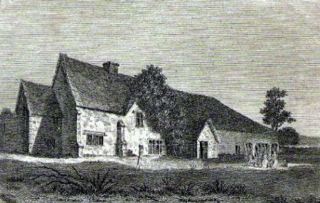Lacock is a village and civil parish in the county of Wiltshire, England.
Lacock or LaCock may also refer to:

Wiltshire is a ceremonial county in South West England. It borders Gloucestershire to the north, Oxfordshire and Berkshire to the east, Hampshire to the south-east, Dorset to the south, and Somerset to the west. The largest settlement is Swindon, and Trowbridge is the county town.

Lacock Abbey in the village of Lacock, Wiltshire, England, was founded in the early 13th century by Ela, Countess of Salisbury, as a nunnery of the Augustinian order. The abbey remained a nunnery until the suppression of Roman Catholic institutions in England in the 16th century; it was then sold to Sir William Sharington who converted the convent into a residence where he and his family lived. It was fortified and remained loyal to the crown during the English Civil War, but surrendered to the Parliamentary forces once Devizes had fallen in 1645.

Lacock is a village and civil parish in the county of Wiltshire, England, about 3 miles (5 km) south of the town of Chippenham, and about 3.7 miles (6.0 km) outside the Cotswolds area. The village is owned almost in its entirety by the National Trust and attracts many visitors by virtue of its unspoiled appearance.

William Longespée, 3rd Earl of Salisbury was an Anglo-Norman nobleman, primarily remembered for his command of the English forces at the Battle of Damme and for remaining loyal to his half-brother, King John. His nickname "Longespée" is generally taken as a reference to his great physical height and the oversize weapons that he used.

Corsham is a historic market town and civil parish in west Wiltshire, England. It is at the south-western edge of the Cotswolds, just off the A4 national route, 28 miles (45 km) southwest of Swindon, 20 miles (32 km) east of Bristol, 8 miles (13 km) northeast of Bath and 4 miles (6 km) southwest of Chippenham.
Events from the year 1835 in the United Kingdom.

Urchfont is a rural village and civil parish in the southwest of the Vale of Pewsey and north of Salisbury Plain in Wiltshire, England, about 3+1⁄2 miles (6 km) southeast of the market town of Devizes. The hamlet of Cuckoo's Corner is in the northwest of the village; the parish includes the hamlets of Wedhampton and Lydeway. The population of the parish at the 2011 census was 1,075.

Bowden Hill is a village in Wiltshire, England, in Lacock parish about 3+1⁄2 miles (6 km) south of Chippenham and 1+1⁄2 miles (2.4 km) to the east of Lacock village. Bowden Hill has about 50 houses, a pub, and a small industrial estate.
Laycock is an English surname, likely originating from the placename Lacock, in Wiltshire or Laycock in West Yorkshire.
Ela of Salisbury, 3rd Countess of Salisbury was an English peeress. She succeeded to the title in her own right in 1196 upon the death of her father, William FitzPatrick, 2nd Earl of Salisbury.

Malmesbury is a town and civil parish in north Wiltshire, England, which lies approximately 14 miles (23 km) west of Swindon, 25 miles (40 km) northeast of Bristol, and 9 miles (14 km) north of Chippenham. The older part of the town is on a hilltop which is almost surrounded by the upper waters of the Bristol Avon and one of its tributaries.
Goring Priory was a medieval monastery of Augustinian Canonesses regular in Oxfordshire, England, established before 1181.

St Mary's Priory was a Benedictine priory of nuns at Kington St Michael in Wiltshire, England. Founded before 1155, the priory was dissolved in 1536.

Sir John Talbot was an English politician, soldier, and landowner, who was Member of Parliament for various seats between 1660 and 1685. He held rank in a number of regiments, although he does not appear to have seen active service.


John Ivory-Talbot, of Lacock Abbey, Wiltshire, was an English landowner and politician who sat in the House of Commons between 1715 and 1741.

Sir Gilbert Talbot was an English diplomat, who held offices in the Republic of Venice from 1634 to 1645, then Denmark-Norway from 1664 to 1666. He was Member of Parliament for Plymouth, from 1666 to 1679.

Lacock Abbey was a monastery founded at Lacock, in the county of Wiltshire in England, in the early 13th century by Ela, Countess of Salisbury, as a house of Augustinian Canonesses regular. It was seized by the crown in 1539 during the Dissolution of the Monasteries under Henry VIII. It then became a country house, Lacock Abbey, notable as the site of Henry Fox Talbot's early experiments in photography.